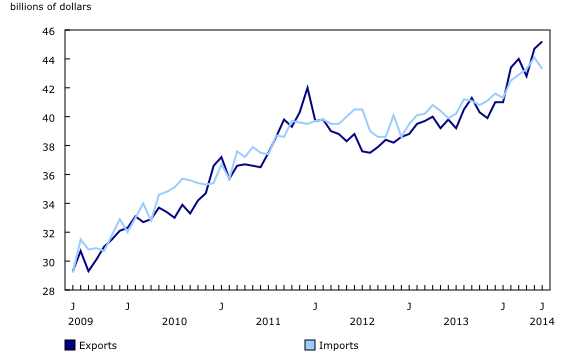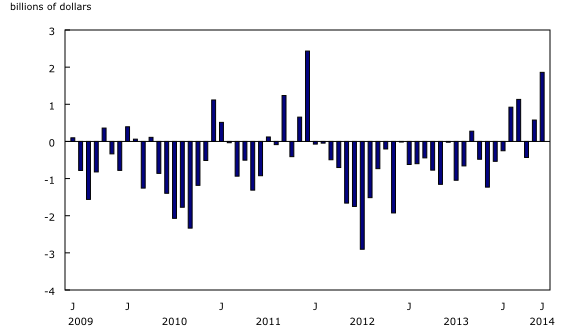Canadian international merchandise trade, June 2014
Archived Content
Information identified as archived is provided for reference, research or recordkeeping purposes. It is not subject to the Government of Canada Web Standards and has not been altered or updated since it was archived. Please "contact us" to request a format other than those available.
Released: 2014-08-06
Canada's merchandise exports rose 1.1% in June, while imports declined 1.8%. As a result, Canada's trade surplus with the world widened from $576 million in May to $1.9 billion in June.
Exports increased to a record high $45.2 billion, led by metal and non-metallic mineral products, consumer goods, and energy products. Volumes increased 1.0% and prices edged up 0.2%.
Imports decreased to $43.3 billion, as declines were recorded in 8 of 11 sections. Volumes fell 1.7% and prices edged down 0.1%.
European Union leads gain in exports
Exports to countries other than the United States grew 4.8% to $11.1 billion, led by the European Union (+12.1%). Imports from countries other than the United States fell 7.8% to $14.3 billion as declines were recorded for the principal trading area "all other countries" (-8.3%) and the European Union (-10.8%). Consequently, Canada's trade deficit with countries other than the United States narrowed from $4.9 billion in May to $3.1 billion in June.
Exports to the United States were unchanged at $34.1 billion in June, while imports were up 1.5% to a record high $29.1 billion. As a result, Canada's trade surplus with the United States narrowed from $5.4 billion in May to $5.0 billion in June.
Exports up on higher volumes
Exports of metal and non-metallic mineral products increased 9.7% to $4.8 billion in June, as volumes rose 10.2%. Higher exports of unwrought precious metals and precious metal alloys (+14.8%) and unwrought nickel and nickel alloys (+35.8%) were the main contributors.
Exports of consumer goods rose 8.3% to $5.1 billion on higher volumes. Exports of consumer goods have been trending up since November 2012. Pharmaceutical and medicinal products (+23.4%), prepared and packaged seafood products (+37.6%) and miscellaneous goods and supplies (+19.4%) all contributed to the section's gains. The increases for all three commodity groupings were entirely the result of higher volumes, as was the case for the section as a whole.
Exports of energy products were up 2.5% to $11.9 billion. Crude oil and crude bitumen increased 2.8% to a record high $8.9 billion, as prices rose 2.2%.
Partially offsetting these increases, exports of motor vehicles and parts fell 6.3% to $6.2 billion in June after recording four consecutive monthly gains. The main factor behind the decrease in June was passenger cars and light trucks, which fell 8.8% to $4.1 billion.
Imports decline on lower volumes
Imports of metal ores and non-metallic minerals fell 25.3% to $752 million in June, following an increase of 45.4% in May. Volumes declined 21.7% in June. The commodity grouping "other metal ores and concentrates" (-35.8%), primarily lead ores and gold bullion, was the main contributor to the section's decrease in imports.
Electronic and electrical equipment and parts declined 4.5% to $4.7 billion on lower volumes. The decrease in imports was widespread throughout the section, with communications and audio and video equipment (-5.4%) contributing the most.
Imports of motor vehicles and parts decreased 2.5% to $7.6 billion, following four consecutive monthly increases. An 8.8% decline in motor vehicle engines and motor vehicle parts was partially offset by a 4.1% increase in passenger cars and light trucks.
Imports of consumer goods were down 2.2% to $8.8 billion, a second consecutive monthly decrease after a record high in April. Volumes and prices both declined. Lower imports were reported for pharmaceutical and medicinal products (-6.3%) and clothing, footwear and accessories (-5.4%).
Note to readers
Merchandise trade is one component of Canada's international balance of payments (BOP), which also includes trade in services, investment income, current transfers as well as capital and financial flows.
International merchandise trade data by country are available on both a BOP and a customs basis for the United States, Japan and the United Kingdom. Trade data for all other individual countries are available on a customs basis only. BOP data are derived from customs data by making adjustments for factors such as valuation, coverage, timing and residency. These adjustments are made to conform to the concepts and definitions of the Canadian System of National Accounts.
Data in this release are on a BOP basis, seasonally adjusted and in current dollars. Constant dollars are calculated using the Laspeyres volume formula (2007=100).
For more information on seasonal adjustment, see Seasonally adjusted data – Frequently asked questions.
Revisions
In general, merchandise trade data are revised on an ongoing basis for each month of the current year. Current year revisions are reflected in both the customs and BOP based data.
The previous year's customs data are revised with the release of the January and February reference months as well as on a quarterly basis. The previous two years of customs based data are revised annually and are released in February with the December reference month.
The previous year's BOP based data are revised with the release of the January, February and March reference months. To remain consistent with the Canadian System of macroeconomic accounts, annual revisions will take place in December with the October reference month rather than in June, as was previously the case.
Factors influencing revisions include late receipt of import and export documentation, incorrect information on customs forms, replacement of estimates produced for the energy section with actual figures, changes in classification of merchandise based on more current information, and changes to seasonal adjustment factors.
Revised data are available in the appropriate CANSIM tables.
These data are now available in the Canadian International Merchandise Trade Database (Catalogue number65F0013X). From the Browse by key resource module of our website, choose Publications.
The June 2014 issue of Canadian International Merchandise Trade, Vol. 68, no. 6 (Catalogue number65-001-X), is also available from the Browse by key resource module of our website under Publications.
Data on Canadian international merchandise trade for July will be released on September 4.
Contact information
For more information, contact us (toll-free 1-800-263-1136; 514-283-8300; infostats@statcan.gc.ca).
To enquire about the concepts, methods or data quality of this release, contact Alec Forbes (613-951-0325), International Accounts and Trade Division.
- Date modified:



